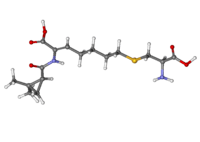Cilastatin
 | |
 | |
| Clinical data | |
|---|---|
| AHFS/Drugs.com | International Drug Names |
| MedlinePlus | a686013 |
| Routes of administration | IV |
| ATC code | J01DH51 (WHO) (combination with imipenem) |
| Identifiers | |
| |
| CAS Number |
82009-34-5 |
| PubChem (CID) | 5280454 |
| IUPHAR/BPS | 5166 |
| DrugBank |
DB01597 |
| ChemSpider |
4940183 |
| UNII |
141A6AMN38 |
| KEGG |
D07698 |
| ChEBI |
CHEBI:3697 |
| ChEMBL |
CHEMBL766 |
| ECHA InfoCard | 100.072.592 |
| Chemical and physical data | |
| Formula | C16H26N2O5S |
| Molar mass | 358.454 g/mol |
| 3D model (Jmol) | Interactive image |
| |
| |
| (verify) | |
Cilastatin is a chemical compound which inhibits the human enzyme dehydropeptidase.[1]
Dehydropeptidase is an enzyme found in the kidney and is responsible for degrading the antibiotic imipenem. Cilastatin can therefore be combined intravenously with imipenem in order to protect it from dehydropeptidase and prolong its antibacterial effect. Imipenem alone is an effective antibiotic and can be given without the cilastatin. Cilastatin itself does not have antibiotic activity although it has been proved to be active against a zinc-dependent beta-lactamase that usually confer antibiotic resistance to certain bacteria; more precisely the carbapenem family of antibiotics. This property is due to the physico-chemical similarities between membrane dipeptidase (MDP), the compound it is usually set to target, and the bacterial metallo-beta-lactamase carried by the CphA gene[1] Therefore, cilastatin is considered a beta-lactamase inhibitor, not an antibiotic per se. But as with other combinations of an antibiotic with an enzyme inhibitor, the combination allows the antibiotic to be more effective by changing the pharmacokinetics involved. Thus imipenem/cilastatin, like amoxicillin/clavulanic acid, is a commonly used combination product.
References
- 1 2 Keynan S, Hooper NM, Felici A, Amicosante G, Turner AJ (1995). "The renal membrane dipeptidase (dehydropeptidase I) inhibitor, cilastatin, inhibits the bacterial metallo-beta-lactamase enzyme CphA". Antimicrob. Agents Chemother. 39 (7): 1629–31. doi:10.1128/aac.39.7.1629. PMC 162797
 . PMID 7492120.
. PMID 7492120.